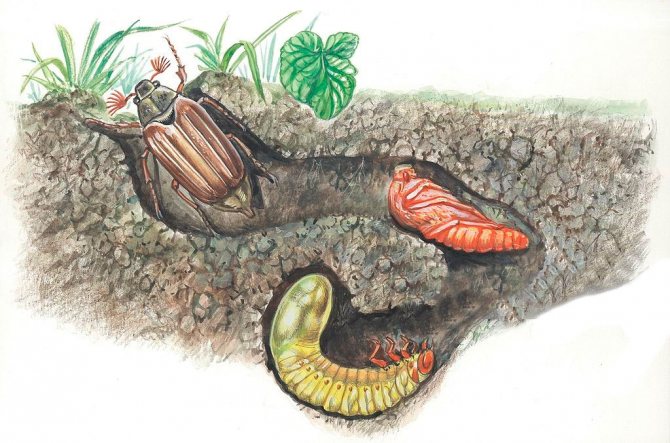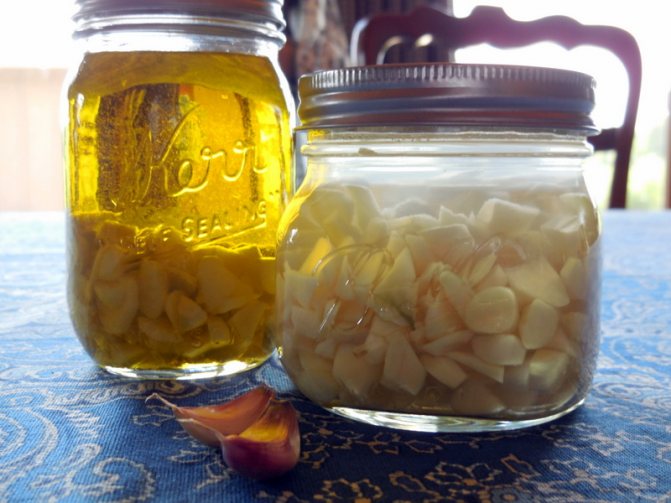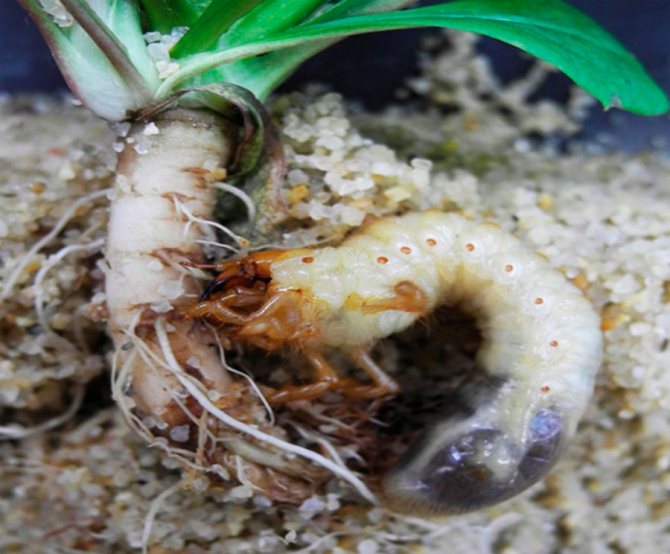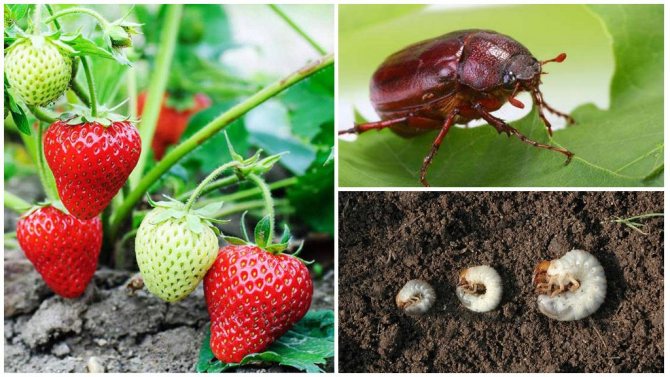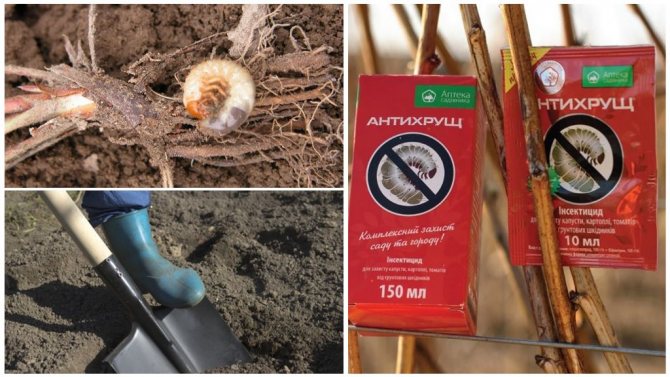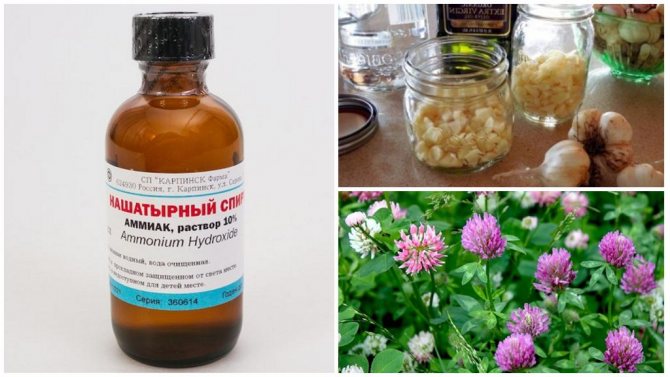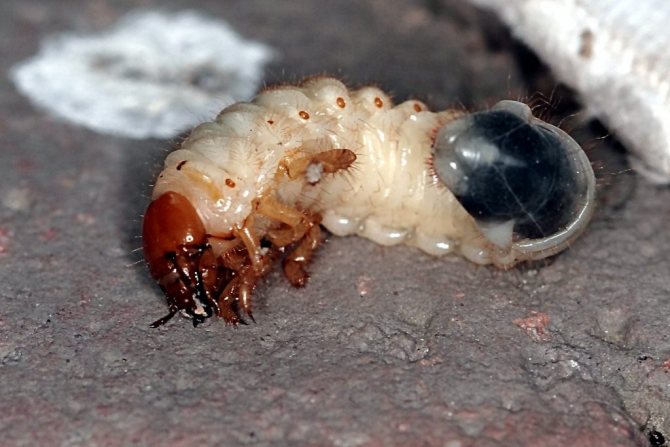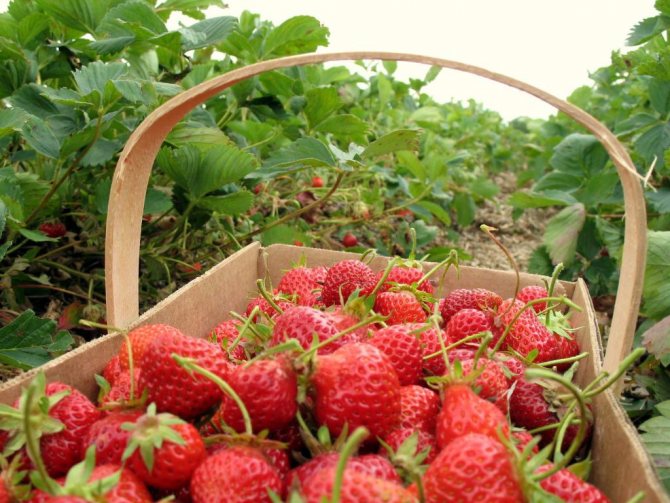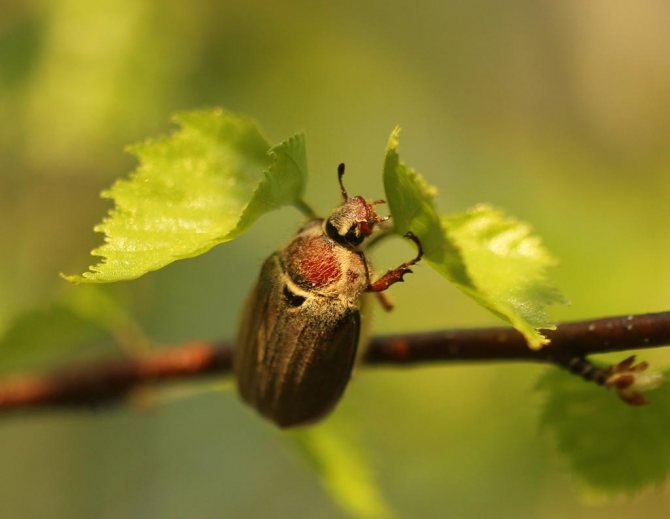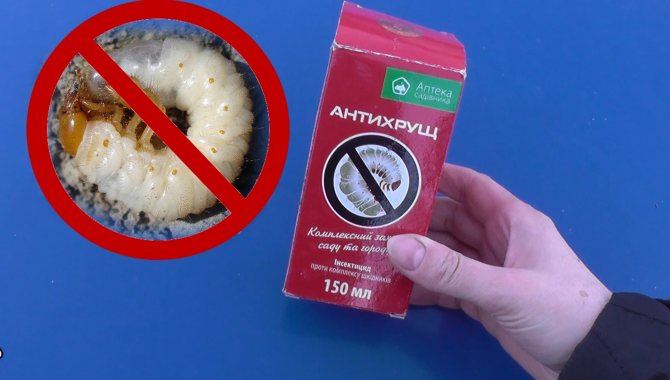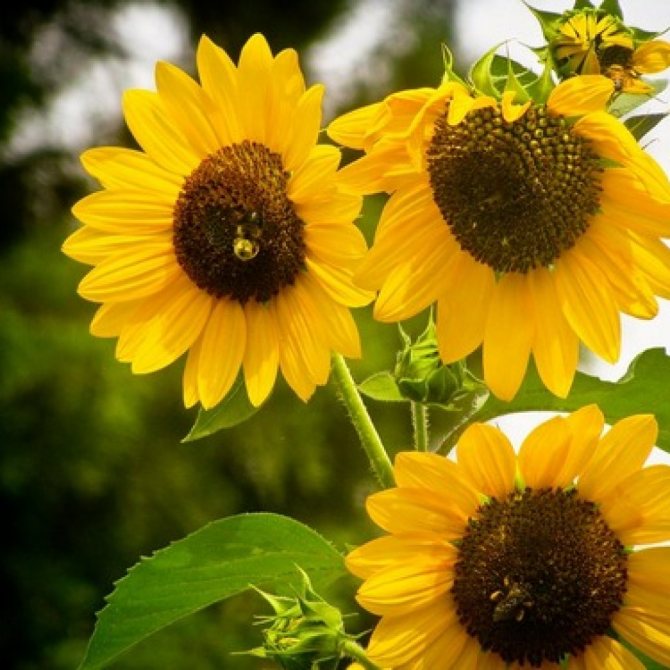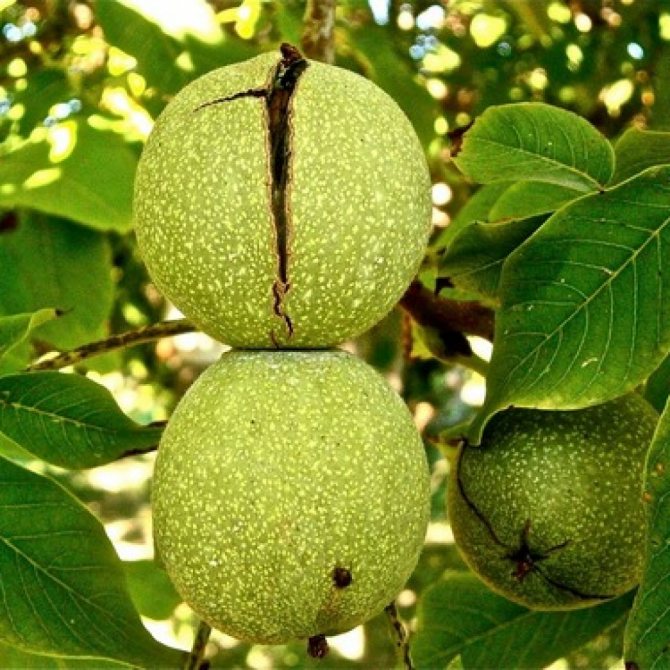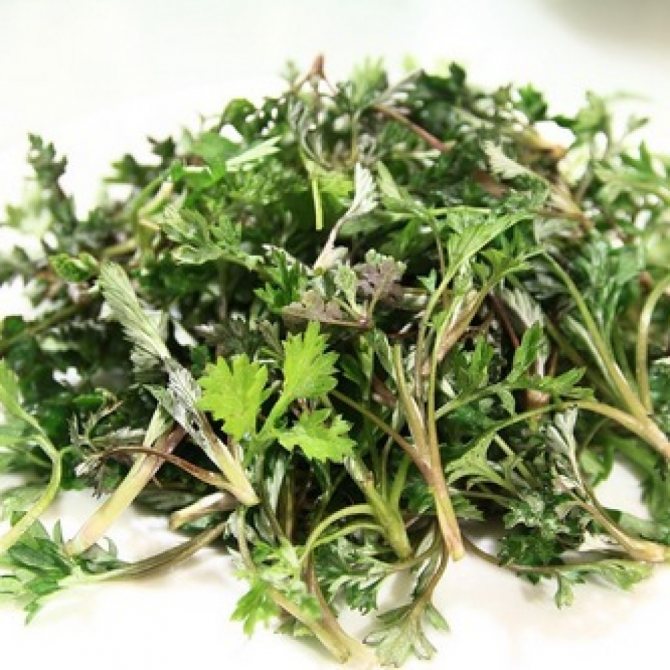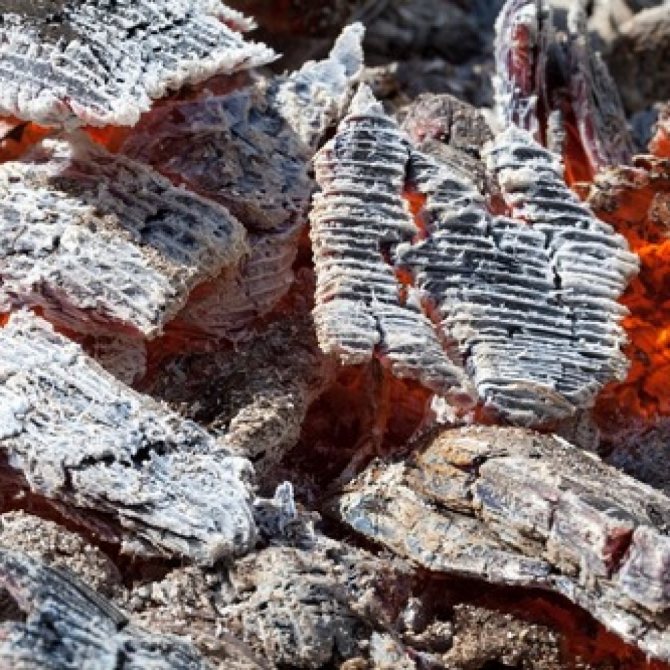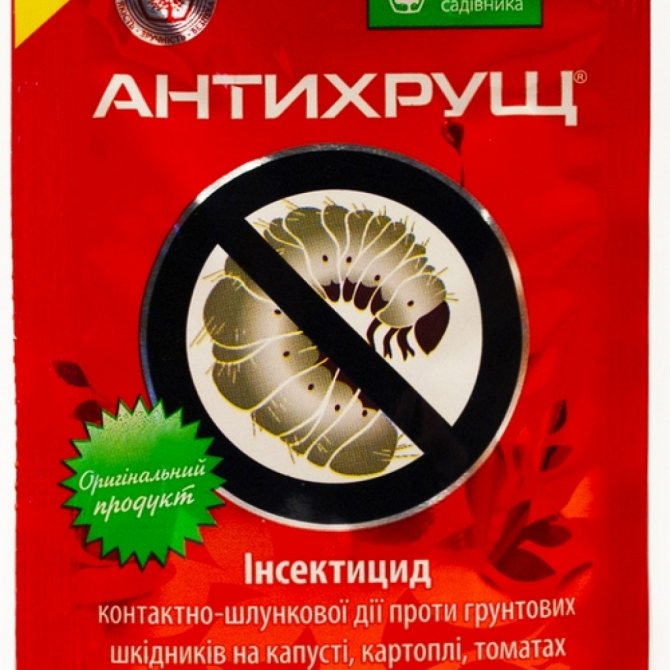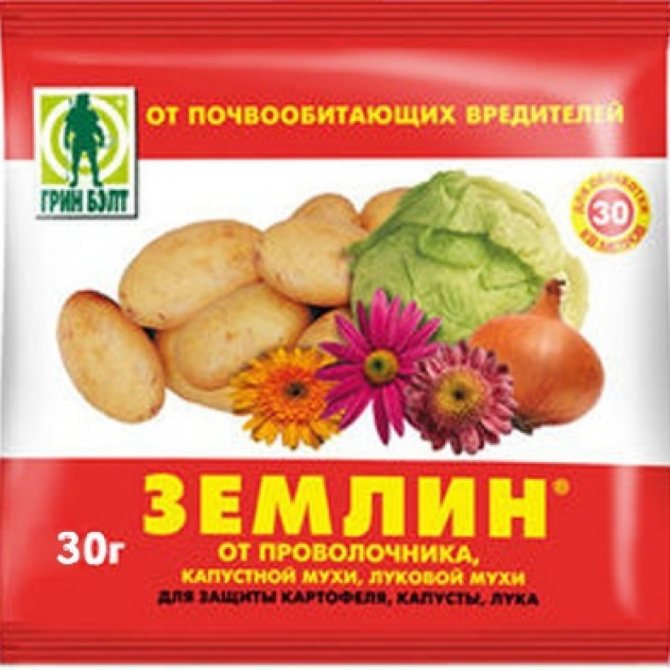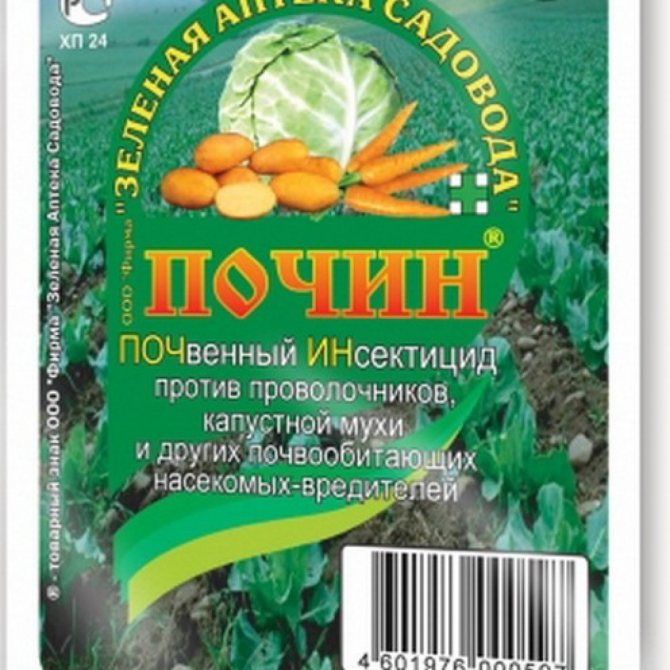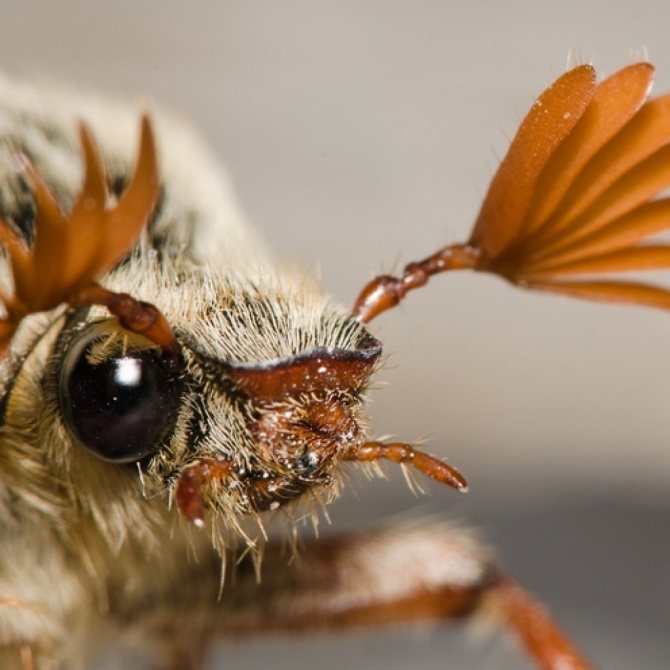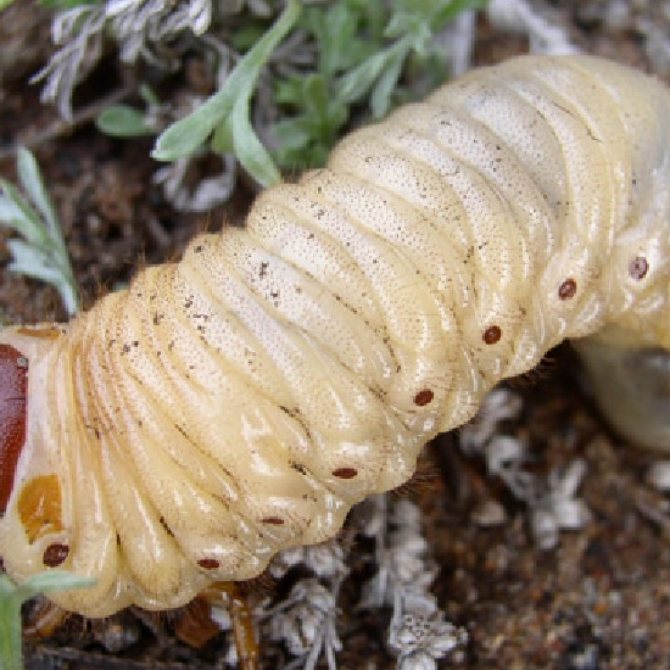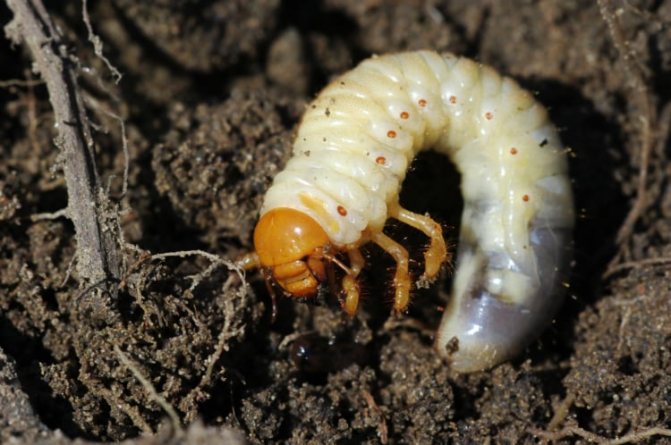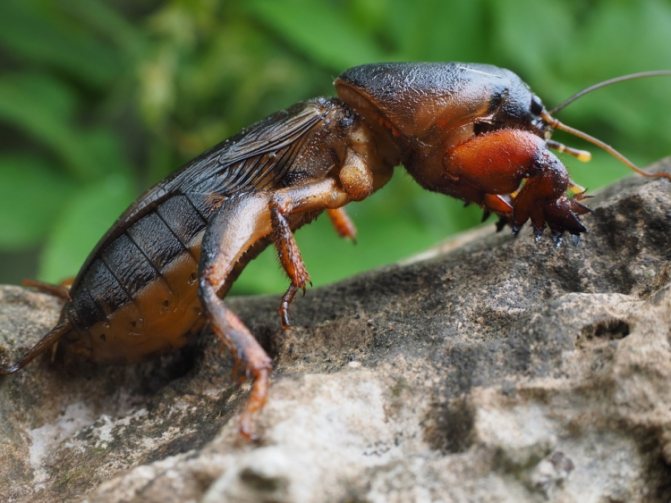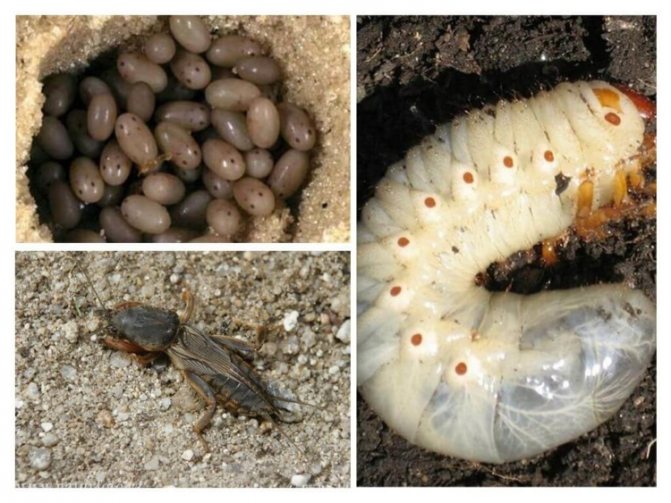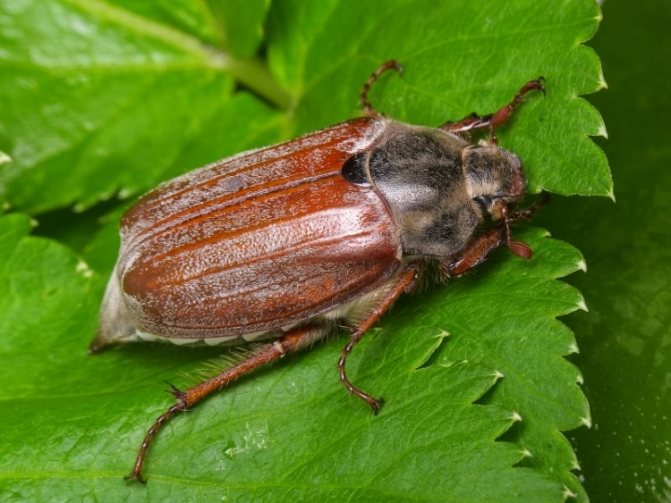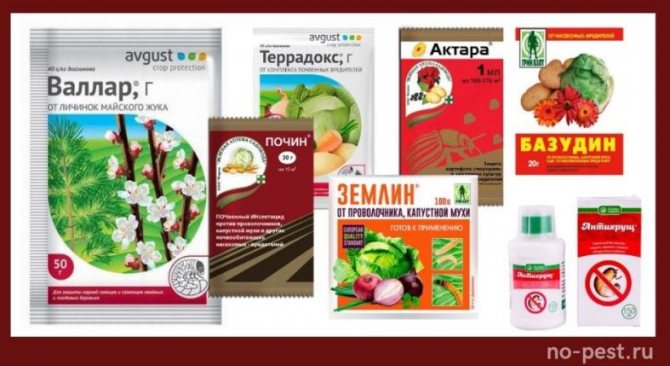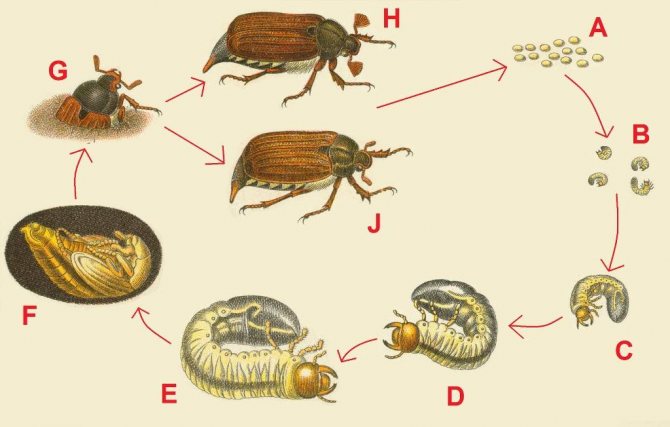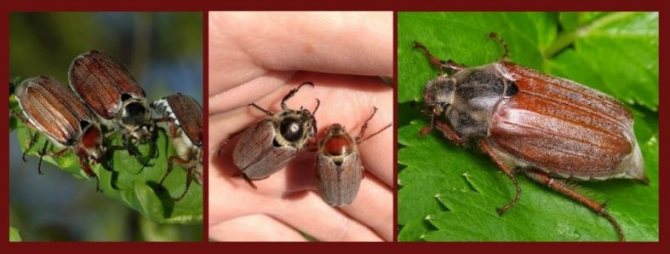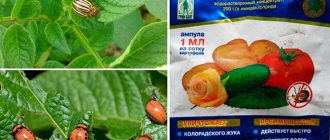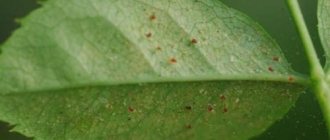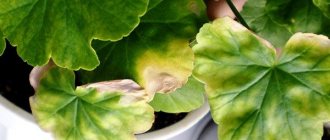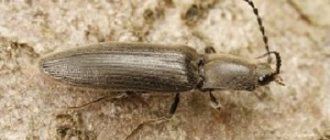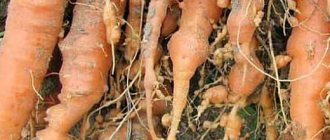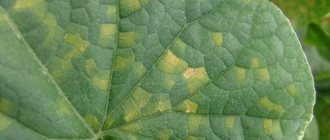The habitat of the May beetles is the states of Europe and Asia. Unfortunately, the appearance of these elegant insects, which are sometimes even kept as pets, is deceiving. These elegant beetles belong to the category of dangerous pests of agricultural crops and are a lot of hassle both on large farm plantations and in backyards and summer cottages.

What does the May beetle or the common beetle look like?
It is easy to identify the May beetle. He has a large, oval body, color - black or brown. The body is completely covered with a chitinous shell and is divided into three segments - the head, chest and abdomen. The belly of the insect has eight sections, and the thorax of three.
The beetle's wings are covered with brown or brownish elytra. The head is retracted into the wings and is dark in color, with a few exceptions. Khrushch also has three pairs of limbs covered with small hairs. Each of the pairs emerges from the prothorax, mesothorax, and metathorax. The legs of the forelimbs have 2-3 teeth.
May beetle is a very hairy insect. On its body there is a huge number of hairs of different lengths, colors and thicknesses. Usually the hair is white or gray in color. In some individuals, because of the hair, their natural color is not visible. This feature makes the May beetles highly recognizable, so that they can be easily distinguished by their dense vegetation.
Khrushchev worms
Every person knows for sure what the beetle larvae look like. They are white and quite large in size. They roll up in a half-ring, are quite noticeable and can be found anywhere. Most often they are observed in vegetable gardens and orchards.
Gluttonous newborn worms are capable of causing colossal damage to the future harvest. They are active mainly in May, but July pests are also found. These include flour and Caucasian marble beetles.
Description


Very thick, white beetle larvae take on a crescent shape... They are covered with fine hairs and look like tiny worms. A year later, they grow up to 5 cm. Closer to the head, the insect larva has three pairs of legs, and the head itself is round. It has brown jaws.
The larvae emerge from eggs, which the beetle lays in the soil several times per season. A female beetle is capable of laying up to 70 eggs at a time. Their habitat is soil, but quite often they get out to its surface. The insect is in the larval stage for 3 years, after which it begins to degenerate into a pupa.
The first year of life, they do not carry much harm to the crop, due to their small size. Initially almost invisible, they feed on humus. After a certain period of time, they feast on the remains of plants, but if they lack such food, they can profit from young roots.
As they grow older, the need for food of the larvae increases. and variety too. In the second year of life, future May beetles feed on larger roots. It happens that they can treat themselves to potato tubers or other root crops.
At the age of two, they are already doing great harm. Plants die, and as for root crops, they rot. The plant begins to wither for no reason, growth stops, even if you follow all the rules for care.
If you do not take measures, then you can even be left without a crop.On the territory of the garden, the larvae infect potato tubers, corn, carrots, and they are also big lovers of cabbage. They gladly settle in strawberry beds and feast on its roots.
How to get rid of?


When digging up the soil, it is necessary to destroy the larvae that come across, to the maximum... It is better to do this in early May. At this time, the dug up soil will disrupt the pupation process, and they will die. If the summer is hot and there is little rain, then the larvae lie deep in the soil, and this method no longer works.
You will be saved by a solution of potassium permanganate (5 g per 1 liter of water) or a solution of table salt (2 tablespoons) and ammonia. Take 2 tbsp for a bucket of water. l. medicines. During the flowering period, such a solution can be used for prophylaxis.
May beetle feels good in the air. We make a trap of light for him. We hang up the light bulbs, and under each we attach a container with water. Add a few drops of kerosene to the water. Insects will fly up to the light and fall into the water trap. Starlings can be used as helpers. Hang a birdhouse on site and don't worry about your crop... Scientists have proven that one family of birds kills at least 8 thousand pests and their larvae.
Stages of development


The female beetle lays eggs after 2-3 weeks of its life cycle. After deposition, she again searches for a male, and the cycle repeats. During her life, a female beetle lays eggs 3-4 times, then dies. The life of a beetle is divided into 4 stages:
- Egg... May beetle lays white eggs 0.3 centimeters long and 0.2 centimeters wide. The egg development cycle lasts from 24 to 50 days.
- Larva... While developing, the egg hardens, then a larva is formed. They are thick and curved, light colored and 65 mm long. In this stage, she can stay up to 4 years.
- Chrysalis... The pupa has a yellowish color and lives in the ground. It looks similar to an adult beetle, but has shorter wings. It is 0.25 centimeters long. The pupal stage lasts 2-4 weeks.
- Adult beetle.
How does it appear on the site?


In most cases, beetle in the country appears through the air. During their adult life, they prefer to be near deciduous trees, periodically flying from place to place. Thus, they get to your site.
The period of increased activity lasts from 20 to 40 days, after which the beetle burrows into the ground, where it lays the larvae, and also hibernates. If a beetle arrives at your summer cottage in the spring, and you don't do anything about it, you are guaranteed to have larvae, and even more beetles next year.
Insects can bury themselves in the ground for a meter and a half, so waiting for the end of the season to start a fight is not worth it.
What do May beetles and their larvae eat?
Insects fly out to hunt in spring, when the air temperature warms up to 10-15 degrees. The main damage falls on fruit plants, they damage leaves, flowers and ovaries. They also do not disdain spruce and foliage of most trees: maple, linden, poplar, oak. The only plants that are safe from these pests are maple and ash.
The diet of the beetle larvae is slightly different from that of adults. In the early stages of development, the larva consumes vegetables and some ornamental plants. Slightly grown ones begin to eat roots, most of all they like the roots of trees and shrubs. The larvae are voracious, so they can completely destroy the root of a small tree in a couple of days.
Description of the beetle
May beetle has a fairly solid size for an insect. Its length can be from 1 cm to 3.5 cm. The body of the beetle can be either oval or almost round in shape, and there are scales on it. Longer hairline can be observed on the belly and on the head. The females of the May beetle are even larger than the males.


Chafer
The beetle is black or brown in color.In the southern regions, you can often find the black May beetle in dark forests with no light penetration. Insects with a different color are found in the northern regions, where vegetation is not too abundant.
Effective ways to deal with adult beetles
In the garden
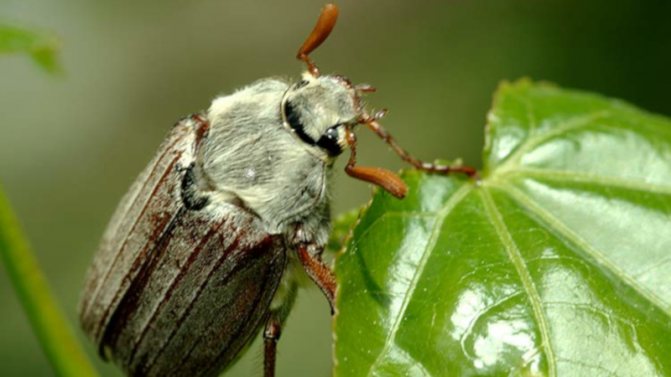

If the May beetle has started up in the garden, first of all, you need to protect fruit, deciduous trees and shrubs. Most often, pests gather in calm and cool weather, morning and evening. This can be used, during periods of congestion of beetles, shake them off and trample them. You can also do this with a shovel, just digging up the soil once a year. This "manual" method is very effective.
Another option is to plant one of the varieties of grass in the garden that the beetle cannot tolerate. An example is the perennial lupine. If you remove the weeds and sow this grass, the mass death of the beetle will begin. This is a simple yet effective remedy.
An alternative to perennial lupine is white clover. It is a plant that takes nitrogen from the air and stores it in the soil. The beetles cannot tolerate nitrogen at all, which makes white clover an effective fighter against the beetle.
One of the most commonplace ways is poison. You can take any insecticide, dilute it in water and pour it over the soil. This procedure should be done about a month before harvesting.
In strawberries
Spraying is an effective method of dealing with beetles on strawberries. To do this, make various solutions and spray them on berry bushes.
Usually solutions are made in ammonia (1-3 tablespoons per 10 liters of water) or iodine (10-15 drops per 10 liters of water).
It is best to spray once a week 2-3 times in a row. So the May beetle can be scared off the most.
How to deal with the May beetle folk ways
Traps
Bait for beetles is easy to make. You need to take a large plastic bottle and cut off the neck of it. Then hang it on a tree, you can attach it to a thick branch, tie it with a cord and fill it with bait about 3/4.
Any fermentation product can serve as a bait drink. Kvass, beer, or fermented jam work well.
The smell of the bait will attract insects, and after they land in the trap, they will not get out of there. The method is effective in that in addition to May beetles, the trap will catch other pests.
Manually
Digging up the beds is a great way to deal with the beetle larvae. Digging between the rows by 30-40 centimeters, it is not possible to completely destroy the entire population of beetles, but it will definitely work out to greatly reduce their number, increasing the chances of survival of the crop.
Help of insectivores
One of the most environmentally friendly and effective methods is to introduce predators into your garden that hunt the May beetle. Many cats and dogs, for the sake of interest, catch May beetles and bring them to their owners. In the wild, they are hunted by hedgehogs, moles and many birds.
The easiest way is to attract birds. Obviously, in order for the birds to fly to the garden, you need to create favorable conditions for them. Install a drinking bowl and a swimsuit, hang birdhouses on branches and poles. Starlings and blackbirds after a while of feeding themselves will begin to flock and exterminate pests.
After the destruction of the May beetle, you will have to save the crops from birds accustomed to eating in your garden.
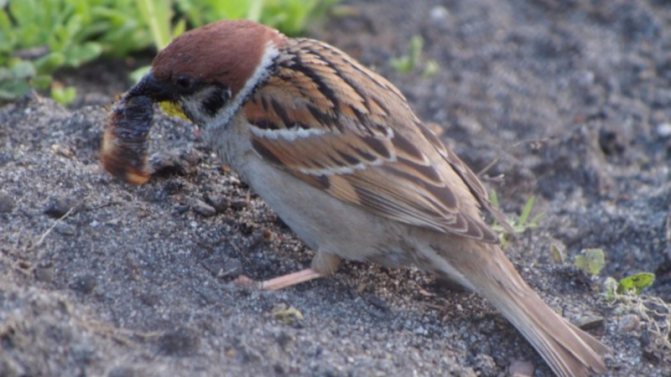

Cabbage worms
Medvedka is one of the most serious pests in the planting area. Among the people, she was nicknamed "earthen cancer". She got this name because of the elastic front back. It looks like the shell of an ordinary crayfish. She flies and floats beautifully in the water. Confidently makes earthen passages and quickly moves along its surface. Crawls out only at nightfall.
For the bear, harsh sounds are characteristic, which create a rather frightening sensation at night.That is why it has another name among the people - the spinning top.
The bear larva is unpretentious in food... Eats eggplant roots, onions, cucumber leaves and sometimes the vegetables themselves, cabbage, potato tubers. She prefers to live in soil where there is a good supply of sunlight. Therefore, if a plant interferes with the penetration of sunlight and restrains its burrow, it is in danger of complete destruction. After all, the insect's mink is very small - the size is no larger than a chicken egg, and its depth is 10-15 cm.
How to get rid of an insect?


First, we will study the insect itself and understand with whom we have to deal. The pest lives throughout the European part of Russia. Lovers of moist, loose soil are located near rivers, where the soil is more moist. On the territory of the garden, her favorite place will be manure, planting cabbage or compost heaps.
If, after rain, around the end of May and the beginning of the first summer month, you notice the appearance of dug wavy patches of land or plants cut off at the base of the territory, or the exit to the surface looks like a small hole, then you are at the mercy of a pest.
The insect's nest looks out a little from the ground. You may not notice it right away. It resembles an ordinary hummock. You can understand that a bear has started up in your possessions by the absence of vegetation around this hummock within a radius of 20 cm.
A clutch of eggs, which are equal in size to a pea, the bear spends quite often, making sure that everything is in order with the offspring.
Pest control
- The consequences after the presence of pests in your garden are enormous. When the entire crop is harvested, it is better to do this in early spring, loosen the ground, or better dig it up as deep as possible. So you will violate the underground possessions of the bear and destroy her egg clutches. Burrows in the garden are unique structures with a large number of moves and exits.
- Plant special plants where the pest lives. Medvedka is frightened by the smell of marigold. For her, it is harsh and has a poisonous pollen. Also, the infected area can be planted with lupines, which are considered perennial. After that, next to these flowers, which will bloom for more than one year, other weeds will no longer grow, and the larvae will have to feed on their roots, and they are poisonous for the future generation of beetles.
- A good way when watering a plot is to use a special infusion of onion husks (for 10 liters of warm water, take 1 kg of husks, leave for 5 days) or their waste. An infusion of chicken manure diluted with water 1: 3 will also help you. You can water the plants abundantly, or spray them daily. Irrigation will allow it to be evenly distributed throughout the plant. And if you combine these two methods together, the effect will be significant.
- The capture of adults is carried out by luring the insect to the smell of vegetable oil. Pour a couple of drops of oil into the bear's mink, wait a little and pour a glass of water. This will give a characteristic odor that the insect senses from a distance. The specimen will crawl up and die.
Description
From May to July, insects end the mating season., it is after this that the bear begins to lay eggs in its nest. At a time, there are from 50 to 500 eggs of future insects. From the outside, they look like millet grains. Dark brown, 3.5 mm long.
If the habitat is favorable, then after 9-18 days the first larvae will begin to appear from the eggs. Food for which, at the initial stage of life, will be the remnants of the shell and the salivary secretions of the mother on the walls of the nest.
After a few days, they will turn into a nymph, which in appearance looks like a full-fledged bear. The transformation into a full-fledged individual goes through a dangerous, lengthy process... Not everyone can cope with it. The weak are at risk of death.
Their full maturation occurs only after a year. From the moment of birth and through the fourth stage of growth, the larva of the bear grows from 15 to 33 mm.The diet includes earthworms and small insects, or the fruits of plants left over from autumn.
Interesting fact: the fertility of the insect is markedly reduced if there are no cereals in the diet.
Chemicals to combat
Antikhrusch
Antichrusch is a pesticide from the larvae of the crustacean. The main advantages of this drug:
- environmentally friendly;
- long-term;
- resistant to rain.
Available in suspension form. To use, you need to dilute the concentrate in water, depending on the cultivated crop, and spray the plant before planting.Suitable for potatoes, cabbage, tomatoes and fruit tree seedlings.
Aktofit
A pesticide for many insect pests. Can be used for both indoor plants and crops. Cannot be used in the rain. Unlike antihrush, it kills adults, not just larvae.
Works through neurotoxins. When an active substance enters the body of the May beetle, it adversely affects its nervous system, as a result, after a while it dies.
For use, the product must be stirred in water and sprayed evenly over the leaves of the plant.
Actofit can be used only at temperatures from 18 degrees.
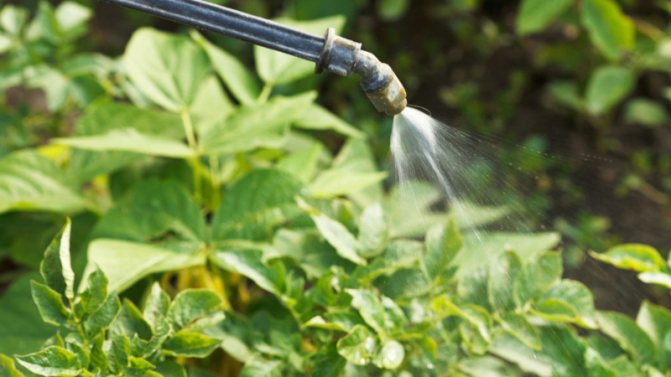

Bazudin
Bazudin is an insecticide that kills pests by contact. The advantage of the drug will be long-term protection with low consumption. 30 grams of bazudin is enough to process 20 square meters of land.
This drug is toxic to fish, so you should absolutely avoid getting it into water bodies. It has minimal harm to a person.
Available in the form of granules. To prepare basudin, you need to take a jar, fill it with sand by 3/4, add the drug, then mix. To protect the potatoes, you need to add the mixture to the hole before planting, the surface of the soil is processed for cabbage. Flower crops are processed in the same way as potatoes.
Zemlin
Another insecticide. Protects crops from many insects besides crustacean. To protect flower plants, it is sprayed on the surface of flowers in a dosage of 30 grams per 20 square meters. To protect the potatoes, add 10-15 grams per hole when planting. Active ingredient: diazinon (50 grams per kg).
Initiative
In addition to beetle, it destroys other soil pests. All effects are the same with earthen. Has a long protection period due to packaging in the form of granules.
It does not need to be bred with anything, it is added to the ground when planting and acts throughout the life cycle of this plant. Works within 24 hours after application.
Types and photos of the pest
Various types of May beetle inhabit almost all of Europe, Asia Minor, the Caucasus, most of the Siberian taiga and Central Asia, Syria, northern Iran, India, Japan, China, also Tibet, Indochina and the Philippine Islands. The main species of the May beetle are the western May beetle, the eastern May beetle and the Caucasian marble beetle.
Western May Khrushch - a beetle 23-32 mm long with a strong, wide and strongly protruding body. The lower part of the body, head and pronotum are black. The coloration of the elytra, legs, antennae, palps and posterior abdomen is light brown, reddish-brown or almost black-brown. This species is characterized by significant color variability and can have a color that is very different from the typical one. They live in most of Europe, in the east in the European part of the CIS.
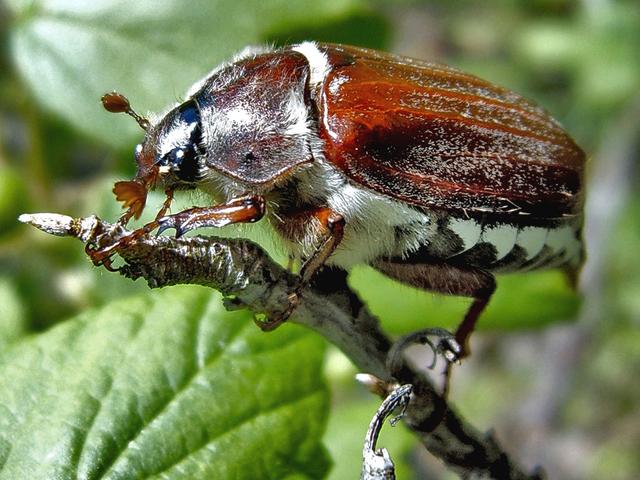

Western May Khrushch
Pronotum dark with short gray-yellow hairs. The elytra are curved, elongated-oval, with 5 thin ribs, covered with frequent short hairs of white or gray color and scattered, the longest, bristling hairs. Base and sides with sparse long, puffy yellowish-gray hairs, ribs with well-defined small punctures. The thorax is covered with long, dense white-gray hairs.The posterior part of the abdomen in the male is elongated at the apex into a thin process, in the female it is slightly shorter.
Eastern May Khrushch or the eastern may beetle is similar to the western may beetle, but has some differences from it in color and in a number of other features. The body is 20-29 mm long. Females are larger than males. The body is large, elongated-oval, curved forward. Coloring is changeable.
The extreme segment of the maxillary palp is elongated, slightly curved. The head is small, retracted into the pronotum and covered with rather dense punctures, with frequent, long, puffy, light yellowish-gray hair. The eyes are medium in size. The posterior part of the abdomen is strongly vertical, passing into a process at the apex. The posterior part of the abdomen is rather steep, at the apex it is narrowed into a process, which is again expanded and rounded at the apex, in the male it is not very long, in the female it has the same width along the entire length, and sometimes it is completely absent.


Eastern May beetle
There are two subspecies of eastern beetle:
- Melolontha hippocastani romana - the upper body, together with the fart, is covered with frequent white hair-like scales that turn into hairs.
- Melolontha hippocastani mongolica - stands out for the strongest, widest body, short and wide back section of the abdomen. Length 19-27 mm.
Caucasian marble beetle - the body of an adult beetle is 30-37.8 mm long; width - 14.2-18.5 mm. Black or brown-black color. Yellow pattern on head and pronotum, white scaly pattern on scutellum and elytra. The color of the antennae club is black-brown.
Biological preparations
Boverin


Another insecticide "Boverin". It is a preparation based on the sporozoans Beauveria bassianl, poisonous for insects.
When it gets on the body of an insect, it begins to germinate and penetrate inside the beetle. After entering the body, the pest releases toxic substances that quickly kill it.
Nemabakt
Biological product for soil pests. The undoubted advantage is environmental friendliness, absolutely does not harm a person and his pets. Kills a beetle at the larval stage.
Used for watering in the morning and evening. After taking it, the larva dies within 1-3 days. There are temperature restrictions, it can only be used at 10-26 degrees and high humidity.
Folk remedies
No matter how effective the chemical or biological remedies against the beetle are, folk methods of dealing with unwanted guests in the garden will never lose their relevance:
- An effective folk remedy will be to collect May beetles from bushes and trees. Beetles are usually harvested in the morning and evening in calm weather. The advantage of the method will be that insects can be used as feed for birds or used as bait for fishing. Otherwise, they should be burned or trampled.
- If there are chickens or other poultry, this can be used as a weapon against pests. Having released them to a site where there is no risk of damage to the crop, they will immediately pull out and eat a lot of grub larvae.
- Dissolve 6 grams of potassium permanganate in 10 liters of water. Water the alleged habitat of the May beetle with a solution. After a while, this will scare them away.
- Table salt is also a good method of prevention and control. Pour a glass of ordinary salt on a bucket of water. Watering the beetles with this solution also gives a result.
Planting lupine for prevention


Lupine is a perennial plant in the legume family. A beautiful and vibrant plant that decorates any garden or room. But, do not underestimate its practical qualities. Firstly, lupine has a very positive effect on the soil in which it grows. It strengthens the soil, protects the land from weeds, which feed on May beetles. Secondly, it collects nitrogen from the surrounding air and enriches the soil with it, destroying the larvae.
Lupine is an unpretentious and resistant plant that does not require constant care.Such a flower is an assistant in protection from pests, moreover, it decorates the site.
The May beetle is an unpleasant insect. He pisses off many farmers and it is really difficult to fight him. However, modern technologies provide opportunities for pest control, from chemicals to old folk methods.
Which method to choose depends on the conditions in which the garden is located. You can use expensive chemicals or folk methods - the result will not be very different.

